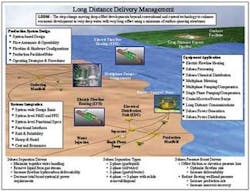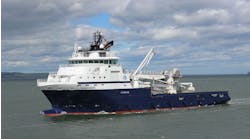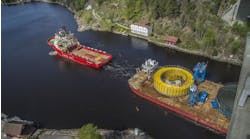Tom Choate, Michael Padilla, Tim Turner, Mac McKee - INTEC Engineering
Two contradictory perceptions are among the major findings and conclusions of a recently completed Joint Industry Project (JIP) on subsea processing technology conducted by INTEC Engineering.
First, subsea oil and gas processing technology – separation, pumping, and/or compression – can handle the operational challenges for many deepwater and long distance tiebacks.
And second, though subsea processing is being implemented by some, many operators do not yet have confidence that the technology is ready.
Uncertainties and a lack of familiarity still outweigh advantages in their eyes.
INTEC Engineering organized and conducted the Phase 1 study on behalf of 14 industry participants. Despite doubts held by some industry players, the JIP confirmed that subsea processing equipment development has advanced substantially in recent years and identified numerous projects that expect to incorporate subsea processing within the next five years. This is clear evidence that subsea processing applications will continue to evolve.
JIP participants represented a cross-section of the global oil and gas industry, including several operators at the forefront of deepwater oil and gas exploration and development around the world, as well as offshore oilfield service and technology companies supporting deepwater activity. In alphabetical order, the participant companies were BHP Billiton, Cameron, Devon Energy, FMC Technologies, Granherne, HFG, HMC, Husky Energy, INTEC Engineering, Nexen Inc., Petro SA, Petrobras, Statoil, Vanco Energy, and Woodside Energy Ltd. Participants served on a steering committee to provide input, guidance, and oversight during the study.
The primary objective of this first phase of the JIP was to ascertain the development history, current operational status, future strategic direction, and general applicability of key subsea processing equipment and technology. The data can help operators better understand the pace of subsea processing capability advancement and can help them determine how subsea processing might be applied now and in the future.
The state-of-the-industry (or art) of subsea processing technology was determined by reviewing available literature and by interviewing operators, suppliers, and vendors of relevant equipment and technologies. INTEC acquired operators’ views of subsea processing in open dialogue during JIP meetings, through interviews with participating operators, and from informal dialogue with companies outside the study group. To complete the industry snapshot, INTEC discussed the current and future vision of subsea processing with equipment and package suppliers and with component vendors.
Subsea processing drivers
This JIP was initiated as an offshoot from INTEC’s ongoing Long Distance Delivery Management program, which focuses on developing subsea production systems for “long-offset” applications: deepwater and/or long distance tiebacks to host facilities or connect to shore.
As is true for all subsea systems, especially Long Distance Delivery Systems, the entire system must be considered and addressed, from development of the original design basis through life-cycle system operation. As water depths and/or offset distances become ever greater, the incentives to use subsea processing technologies increase.
Other considerations aside, operators prefer processing equipment above the waterline where the environment is less severe and where the equipment can be readily serviced and repaired. However, as with subsea production equipment in general, there are reasons for designers and operators to deploy subsea processing for specific field applications. Some of the key drivers are highlighted below.
Subsea separation drivers
Minimize topsides water handling – The high cost of installing water handling/disposal equipment on a topsides facility, particularly for facilities not designed for this purpose, is often a rationale for subsea water separation. However, this is an issue that requires a great deal of careful design and application, as the cost of installing and maintaining subsea water (and sand) handling equipment can be high. Any two-phase (gas/liquid or oil/water), three-phase (gas/oil/water), or four-phase (three-phase with solids removal/disposal) production will have to deal with solids accumulation and/or disposal.
Remove gas from gas/liquid stream (two-phase gas/liquid separation) – Separation of a production stream into gas and liquid streams can improve subsea pumping/compression efficiencies and/or minimize hydrate formation potential. Relatively low-tech two-phase separator designs should see wide application in the industry.
Increase flowline hydrocarbon deliverability (two-phase water/oil separation) – If the decision is made to produce high watercut wells in multi-well and/or multi-field production systems, separation of water from high watercut oil/gas streams will maximize hydrocarbon deliverability in the production flowlines. However, there may be little or no benefit from water removal for single-well or single-field production systems since produced water helps keep flowlines warm when oil production rates drop.
Subsea pressure boost drivers
Pressure boost at the inlet of long production flowlines can be required to:
- Provide the driving pressure required to offset frictional pressure drop
- Increase flowline capacity
- Optimize flowline diameter (use a smaller diameter flowline than reservoir pressure alone would allow)
- Maintain flowline operating pressure or increase process arrival pressure above that which reservoir pressure alone would allow
- Compensate for low reservoir pressure
- Allow low-pressure and high-pressure wells to produce to a common manifold
- Provide the pressure boost to offset hydrostatic pressure loss. This is significant for very deepwater applications where gravitational head pressure – particularly for lines that are liquid-filled for shut-in – will dominate the design. Applying pressure boost at the remote end of the flowline instead might work, but providing it at the base of the steep incline will simplify power distribution and control.
- Reduce flowing wellhead pressure to increase well production rate and/or to increase reservoir recovery. Extending well life by reducing reservoir abandonment pressure tends to exacerbate water production issues.
JIP description
For purposes of the JIP, INTEC chose to restrict the Phase 1 Study to key “subsea processing” technologies: subsea separation, subsea pumping, subsea compression, and the subsystems required to power and control the equipment. Subsea separators, pumps, and compressors were studied because they are core technologies that enable a subsea processing project. Power and controls equipment were studied because they are integral to the processing equipment itself and because they must be considered in order to adequately evaluate complete subsea processing systems.
INTEC compiled data for more than 30 projects in which subsea processing technology plays or will play a role. The earliest project listed is 1968. Other projects will initiate production as far into the future as 2020. Though the industry has taken approximately 20 years to reach its current state of relative readiness, it seems assured of a robust future.
In the JIP report, each subsea processing project is identified by field name and region, categorized as conceptual, qualified, or installed, and organized according to the subsea processing technology: Separation, pumping, and/or compression. Project-specific details include length of tieback, water depth, throughput, and other unique field and reservoir characteristics. Equipment-specific capabilities are shown in terms of water depth, tieback distance, throughput, and differential pressures. Development chronology and readiness-for-use data also are reported.
Focusing on operators’ needs
Subsea processing has interested the oil and gas supply industry since the first subsea production projects were implemented over 50 years ago. Some elements of subsea processing technology have been in operation for years. JIP researchers identified initiatives in progress around the world to develop subsea pumping, subsea compression, and subsea separation equipment. These initiatives are directed at both brownfields, which may be nearing the end of field life, and fields in the conceptual stage.
JIP data shows that operator confidence in subsea processing is increasing. Deployment and operation of subsea processing equipment will lead to further design development and to equipment maturity, with the inherent reliability/maintainability improvements that come with that maturity. Guided by operators’ needs, equipment vendors and subsea systems engineers can be expected to continue the evolution of subsea processing technology for design and deployment of increasingly effective systems.
JIP report
The JIP technical report, comprising text, trend charts, and a supplier matrix, presents a source on the parallel efforts of operators, equipment manufacturers, and vendors working to advance subsea processing technology. Based upon the findings and conclusions of this initial assessment of subsea processing technology, INTEC is planning a second phase to the study. Areas for study are being discussed with current steering committee members and other interested parties.
To learn more about the Subsea Processing Phase 1 JIP, or to contribute to the preliminary discussions for Phase 2, contact Tom Choate,[email protected], or Michael Padilla, [email protected].




